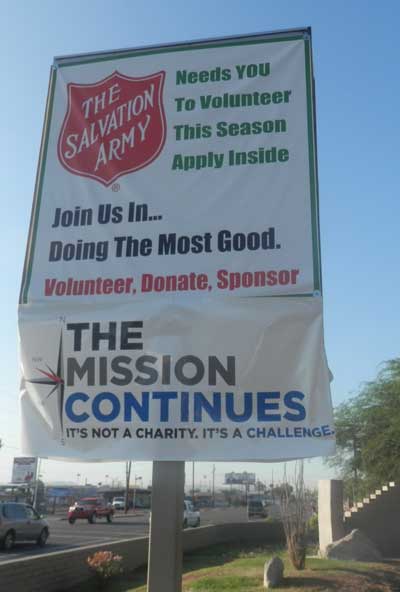By Jim Reid, Dr.
Recently, Dr. Jim Reid, the Henderson (Nev.) Corps’ kettle coordinator learned that Henderson had the highest kettle income in the Southwest Division. Hoping to spread the wealth to other corps’ kettle campaigns, he wrote a step-by-step guide to success.
This is part two of his plan, with specifics of the daily kettle routine. If you missed part one in New Frontier (vol. 29, no. 16), find it online at newfrontierpublications.org/nf/?p=1922.
Before the campaign begins, I go to every store, reintroduce myself to the manager and talk to the customer service people. I tell them if they have any problem with a worker to call me. Several years ago I heard from one customer service person, who said my worker was taking the kettle into the restroom and getting out change to play the slot machines. If the employee hadn’t placed that call, we never would have known.
The “war” room is control central. On the wall, I mount four 4’ by 8’ sheets of white board. Three of them have 70 horizontal lines about an inch apart, and 35 vertical lines about an inch and a half apart. We have six routes. Each location is listed on the left side of the board with the name of the store and its address. Each store has a number. Store number 101 means that it is on route 1 and is stop number one on that route. The vertical spaces are numbered with the dates of the entire campaign.
When I assign a worker to store 101, I write the worker’s number, which I get from the fourth white board, in the appropriate space. For instance, worker number six has been assigned to store number 101 on Dec. 4. If the store has more than one door, I split the appropriate square in two so I can write in the numbers of both workers.
The fourth white board, with 100 lines, is my worker board. I usually hire 80 to 90 people; each one receives a number. One woman here is an expert on filling out the employment application. She makes sure everything is right before it is submitted to divisional headquarters, which saves a lot of time and worry. When I assign a person a spot, I know they have already been approved.
Day in the life of a kettle coordinator
My job begins at 7 a.m. I make sure that all of the first shift locations are covered. I tell the ringers to call me early if they cannot work. If I have a vacancy, I go to the callboard and contact the next person on the list to fill in for that day at that spot. Once I have assigned a spot, I tell the ringers that it is theirs until they are unable for whatever reason to fill it.
With so many people working for us, we expect some not to be able to work on any given day. Missing one day does not cause a ringer to lose a spot; three days would. Once I know all locations are covered, I handle any problems: Smith’s 304 doesn’t have a bell; there is no kettle at Wal-Mart 407, etc. At 8:30 a.m. I send out the single shift drivers. This takes me to about 10 or 10:30 a.m., when I check on my counters. We usually exchange light-hearted banter—I predict how many $100 bills they are going to get that day. If I am correct, I tell them a prophet is in their midst; if I am wrong, I am labeled as a false prophet!
Once the campaign is under way, I place a thermometer on the chalkboard with dollar increments. Each day, I get the total count and move the red of the thermometer up.
About 11 a.m., Major Cobb, the corps officer, arrives to supervise the volunteer kettle counters and to prepare the money for deposit. I go home for lunch and a nap, returning at 2 p.m. to prepare the second shift and pick up the first. I then put out the afternoon “fires.” By now it’s 3:30 or 4 p.m., and time for the single shift drivers to arrive to pick up their bell ringers at 6 p.m. At about 7:30 p.m., Major Cobb takes over and I go home for the night. The Major stays until the 9 p.m. pick-ups are complete and all is secure for the night.
Encouragement matters
Before we send ringers out every shift, I give them a “rah-rah” speech, and tell them to make me proud. I brag on everyone who had a really good kettle, and give them all a pat on the back. For this month, we become like one big, happy family.
Early on, Cobb jokingly called me the “head ding-a-ling.” That tag stuck and it now appears on my business card.
Concerning overtime, I have been fussed at by my corps officer and indirectly chastised by divisional headquarters that the Army doesn’t pay overtime. My response is “why not?” If your kettle coordinator is on top of it—and with the new Salvation Army software for kettles, he/she should be—what is the problem?
The week after Christmas, we have a victory party. We invite all our bell ringers, paid and volunteer, and their families. We rejoice in the tremendous thing that God has done through us. We let everyone know from beginning to end that this is a God thing in which they have been involved. He gets the glory and we get the cash!
Will anyone accept my challenge? You now have our complete formula and all the secrets we use. Duplicate our success—give us a run for our money! Let’s have every corps increase its kettle income this year.
Contact me at jreid31@cox.net.














